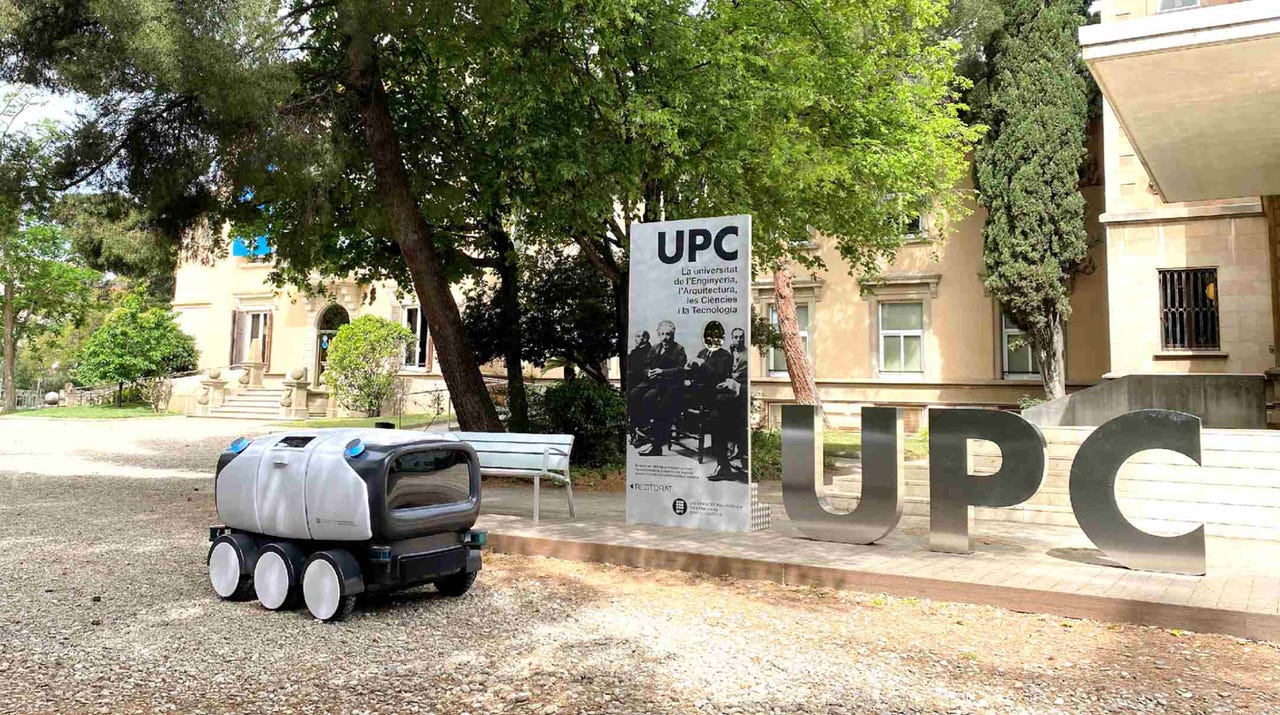Your pizza can already be delivered by a robot, but regulation is still in the oven


In the urban logistics field, autonomous robots are finding their feet – or rather, their wheels.
This development makes sense: the COVID-19 crisis has boosted online sales and multiplied the number of vehicles delivering things. Our "I want it all and I want it now" behavior has worsened congestion in city streets, air quality, noise pollution, use of public land, and hastened the deterioration of sidewalks.
Of course, retail companies are also interested in finding innovative solutions to these challenges, as the last mile represents up to 40% of total transport costs. With global e-commerce sales jumping to $26.7 trillion last year and global spending on last-mile delivery set to reach $62.7 Bn by 2027, the opportunities for new advances are ripe.
In Barcelona, the Polytechnical University of Catalonia (UPC) recently tested its Autonomous Delivery Device (ADD), which has been designed, manufactured, and piloted in Catalonia. The six-wheel vehicle can carry a payload up to 100kg and has a range of 80 km – or around five hours of drive time.
Innovation
The ADD is equipped with LIDAR sensors and a communications system that allows the robot to stay in touch with whoever's cargo it's carrying. So, if you were to order a pizza from a local ristorante, the ADD would send the hungry recipient a notification to confirm the order, along with a code, which can be used to access the vehicle and its tasty contents when it arrives – hopefully still hot.
SEE: How to talk about tech: Five ways to get people interested in your new project
Test runs of ADD have been a success. The vehicle has proven itself capable of getting from A to B in one piece and can quite comfortably navigate sidewalks up to 20cm (7.87 inches) tall and re-route itself, all while avoiding potential hazards and obstacles.
But test environments are not representative of real-world conditions. Laia Pagès, researcher at the Cooperative Automotive Research Network (CARNET, which designed and developed ADD together with UPC) acknowledges that all parameters for the test were controlled. What's more, the area covered in the test was narrow – just 50 meters – and took place on the university campus.
Cities are, of course, much more complex – and unpredictable. Sidewalks are crowded by pedestrians – and often by bicycles and scooters too, contrary to local laws – and there are no lanes reserved for micromobility vehicles.
Weather is also an issue. "When it rains, things are much more complicated, as sensors are going crazy," Pagès says. But "it's worst in Northern countries when it snows."
Despite this, UPC and CARNET are optimistic that their autonomous delivery bot can make a positive impact. ADD is fully electric and was programmed to be used by night, when the city is calmer, meaning acoustic pollution is reduced and congestion can be avoided.
The ADD's rerouting system has also proved itself to be highly capable, meaning less chance of important deliveries (or take-outs) going missing. Of course, night-time deliveries bring their own set of challenges, such as vandalism and thefts. However, Alberto Sanfeliu, a UPC professor and researcher who participated in the design of the ADD, says such issues are not a priority for now.
"The main hurdle is that these kinds of vehicles are still not certified to co-exist and interact with other vehicles", Sanfeliu tells ZDNet. It's precisely for this reason that the Dirección General de Tráfico (DGT), the Spanish body responsible for road policy, is a partner on the project.
The Goggo Cart and Goggo Bot.
In Madrid, autonomous mobility provider Goggo Network is also testing an autonomous robot for last-mile deliveries.
Founded by entrepreneurs Martin Varsavsky and Yasmine Fage in 2018, the company has developed two autonomous delivery vehicles in the form of the Goggo Cart and the Goggo Bot, both of which have been successfully trialed on the streets of Las Rozas (near Madrid) and hope to be a glimpse into the future of urban micromobility in Europe.
Like ADD, Goggo hopes to prove it can change the way goods deliveries are made in urban areas. But before it can, cities need to adapt regulations and establish exactly how autonomous robots can share space with other vehicles and pedestrians. Part of the problem is the layout of the cities themselves: in Spain, urban areas are very dense cities, and the use of public space is a contested issue.
CARNET's Laia Pagès hopes positive developments will come from further tests of ADD this year in Spain, Hungary and Germany within the framework of the LogiSmile project, which is funded by the European Institute of Innovation and Technology (EIT) and began in January 2022 to promote more sustainable and habitable urban spaces.
SEE: Automation could make 12 million jobs redundant. Here's who's most at risk
UPC has designed a second ADD with slightly different characteristics and is hoping to establish a startup through which it can market its vehicles.
But regulation is no easy thing to tackle. The new Spanish Law on Traffic and Road Safety, which came into force on 21 March 2022, only establishes that it's legally binding to include the operating system and characteristics of an autonomous vehicle when registering it. As such, guidance remains thin – and complex.
Daniel Serra, director of Innovation Hub South at EIT Urban Mobility, points out that the regulation for scooters has taken 15 years because of the different layers of administration that need to be agreed before it passes through law. A European regulation for autonomous vehicles might be ready by 2025, Serra says. Meanwhile, the Spanish Ministry of Transport, Mobility and Urban Agenda is currently promoting sandboxes to test regulation.
Acceptance is key
Public acceptance will also play a decisive role in the fate of Spain's autonomous delivery ambitions. An important concern beyond technological problems – like sensors going haywire in the rain – is whether citizens will embrace their new, wheeled co-pedestrians.
To gauge public opinion, UPC is carrying out surveys to measure citizens' acceptance of autonomous vehicles. What is clear, says Sanfeliu, is that these vehicles need to be "secure, robust and predictable". If they can meet this criterion, the professor is confident that "people will get used to them."
Goggo Network's Goggo Bot will be put through real-world testing in Madrid, Barcelona and Zaragoza later in 2022.
Fage points out that autonomous vehicles could provide critical in addressing a shortage of delivery drivers in Spain as e-commerce skyrockets, noting that delivery bots have already hit the roads in other countries that have been quicker off the mark, including the UK and US.
"We must ensure that the same happens in Spain," she says.